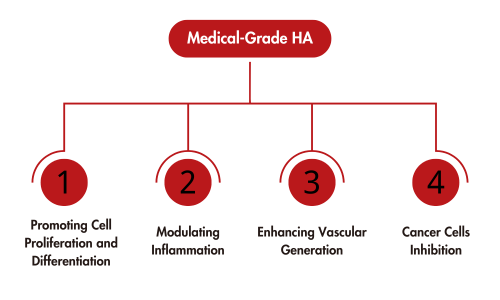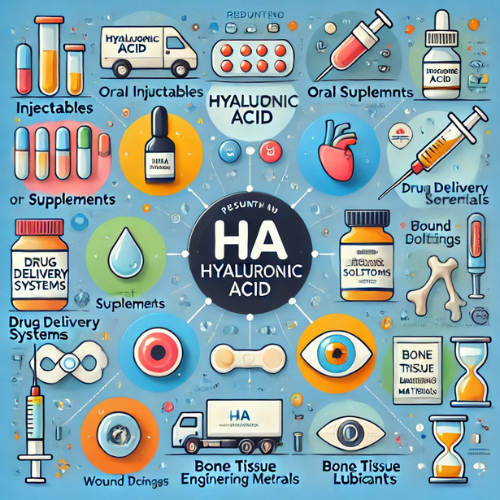Exploring the Medical Value of Hyaluronic Acid (HA)
Hyaluronic acid (HA) is the simplest glycosaminoglycan and a key component of the extracellular matrix (ECM). Most people associate HA with cosmetic and skincare applications, but its medical potential is equally impressive. As research advances, HA is playing an increasingly important role in the health and life sciences field.
History of Hyaluronic Acid
In 1934, scientists Karl Meyer and John Palmer first isolated HA from the vitreous of cow eyes, discovering its unique moisturizing and lubricating properties. HA’s medical applications began over 70 years ago. Using time as a clue, we can clearly see the application history of hyaluronic acid.
- 1934 – HA was first isolated.
- 1930s-40s – HA was extracted from synovial fluid, skin, umbilical cords, tumors, and rooster combs.
- 1940s-50s – HA began to be used in medicine and eye surgeries, especially in cataract treatments.
- 1951 – The chemical structure of HA was determined.
- 1970s – Cartilage proteoglycans were found to interact specifically with HA.
- 1980s – HA was widely used to treat arthritis and introduced into cosmetics and skincare.
- 1993 – Hyaluronate synthase was discovered and cloned from Group A streptococcus.
- 1999 – The first purification of active HA synthase.
- Today – HA is mainly produced through bacterial fermentation, an efficient and eco-friendly method widely applied in pharmaceuticals, skincare, and biotechnology.
Medical Value of Hyaluronic Acid
Hyaluronic acid has a wide range of applications in the medical field: cell proliferation and differentiation, regulation of inflammation, vascular generation, and treatment of tumor cancer.
Fig 1. Benefits of Medical-Grade HA
1. Promoting Cell Proliferation and Differentiation
HA is an important substance in cell proliferation and differentiation. As an essential component of the ECM, HA could create a proper microenvironment for cell regeneration to help in wound healing and repair of cartilage tissue. For example, HA enhances chondrocyte cell proliferation, which is very effective in cartilage regeneration and also in the functional recovery process.
2. Modulating Inflammation
HA is an important mediator in the regulation of inflammatory processes. It may modulate the activity of immune cells, thereby reducing excessive inflammation, which may prevent tissue damage. In this respect, intra-articular injections of HA may reduce pain and improve functional ability in certain clinical conditions such as osteoarthritis. It reduces inflammation during the healing of skin wounds and hence promotes tissue repair.
3. Enhancing Vascular Generation
HA contributes to the process of angiogenesis-or, new blood vessel formation-which is important in processes such as wound healing and tissue regeneration and some pathologies such as tumor growth. HA functions through interaction with its receptors to enhance migration and proliferation of endothelial cells and, thus, hastens vascular formation. This mechanism not only helps accelerate wound healing, but can also play a positive role in certain therapeutic areas, such as the treatment of ischemic diseases.
Read more: Top 10 Benefits of Hyaluronic Acid
4. Cancer Cells Inhibition
HA has been in focus in application to cancer treatment. In the case of low molecular weight HA, Exogenous LMW-HA may exert anti-tumor effects by directly triggering an immune response, decreasing the proliferation of tumor cells, or remodeling the tumor microenvironment. Though partially unclear, Exogenous LMW-HA has been proposed to interact with specific immune cells and interfere with tumor cell signaling. More recently, HA has been suggested for application in improving the diagnosis of cancer and as part of targeted drug delivery systems, offering higher specificity in cancer treatments.
Reference: Does Hyaluronic Acid Cause Cancer
Table 1. Overview of the medical value and application of hyaluronic acid
| Medical-Grade HA | Medical Values | Applications |
| Promote Cell Proliferation and Differentiation | Tissue regeneration, wound repair, cartilage repair | |
| Modulating Inflammation | Osteoarthritis, skin wound healing | |
| Enhancing Vascular Generation | Wound healing, ischemic diseases | |
| Cancer Cells Inhibition | Anti-cancer, anti-cancer drug delivery |
Biomedical Products Based on HA
Due to its biocompatibility, biodegradability, non-toxic, and non-immunogenic properties, several biomedical products have been developed based on HA:
- Injectables: Used for skin fillers, joint lubrication, and anti-aging treatments, such as facial fillers and joint injections.
- Oral Supplements: Often used to improve skin hydration, quality, and joint health.
- Drug Delivery Systems: HA serves as a carrier for slow drug release, improving absorption and bioavailability at specific sites.
- Ophthalmic Solutions: Such as artificial tears and corneal repair solutions, used to alleviate dry eyes and promote corneal healing.
- Wound Dressings: HA promotes wound healing and is used in treating burns, ulcers, and other injuries.
- Bone Tissue Engineering Materials: Used to promote bone and cartilage regeneration.
- Contact Lens Lubricants: Provides comfort and relieves dryness for contact lens wearers.
Fig 2. Biomedical Products Based on HA
Conclusion
As a biocompatible and biodegradable compound, HA holds immense potential as a bioactive molecule for various physiological and pathological conditions. Its applications span from skincare benefits to cancer treatment, inflammation regulation, and chronic disease management. With advancing technology, we can expect more efficient production processes and innovative therapeutic products in the future.
Stanford Chemicals Company (SCC) is a professional supplier of hyaluronic acid. SCC offers high-purity, high-quality, and safe sodium hyaluronate powder (including food-grade, cosmetic-grade, medical-grade, and injectable-grade). All of SCC’s hyaluronic acid products are made using the bacterial fermentation method, ensuring safety and reliability.
List of Medical-Grade Sodium Hyaluronate Powder:
Reference:
Iaconisi, G.N.; Lunetti, P.; Gallo, N.; Cappello, A.R.; Fiermonte, G.; Dolce, V.; Capobianco, L. Hyaluronic Acid: A Powerful Biomolecule with Wide-Ranging Applications—A Comprehensive Review. Int. J. Mol. Sci. 2023, 24, 10296. https://doi.org/10.3390/ijms241210296


